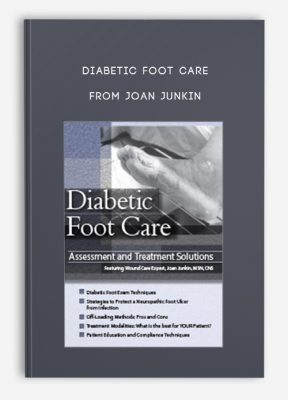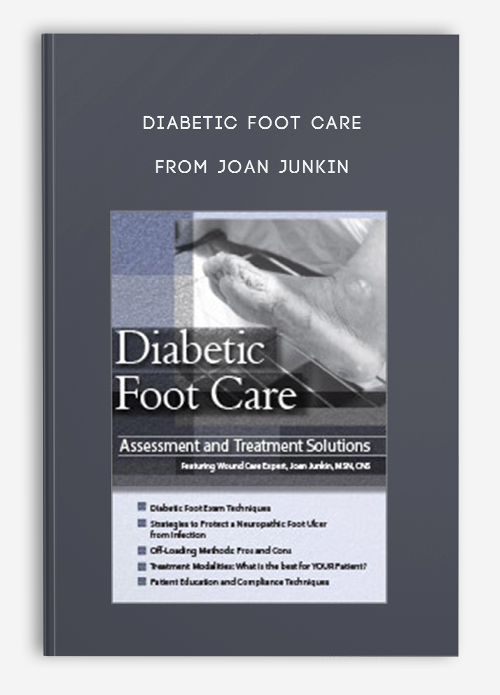Diabetic Foot Care from Joan Junkin
$219.00 $65.00

Diabetic Foot Care Assessment and Treatment Solutions from Joan Junkin
Faculty:Joan Junkin
Duration:Full Day | Format:Audio and Video
Archive : Diabetic Foot Care from Joan Junkin
Get Diabetic Foot Care from Joan Junkin on Salaedu.com
Description:
- Diabetic Foot Exam Techniques
- Strategies to Protect a Neuropathic Foot Ulcer from Infection
- Off-Loading Methods: Pros and Cons
- Treatment Modalities: What is the best for YOUR Patient?
- Patient Education and Compliance Techniques
Foot and lower extremity care in Diabetic patients is more than “challenging”; it’s downright perplexing at times. Improper foot care in diabetic patients can lead to extremely high risk wounds, amputation and even death. Identifying care needs in this population is a complex maze of unique neuropathic changes in the diabetic patient, further complicated by a tangled web of co-morbidities. Foot examinations are a whole other challenge, riddled with sometimes obscure cues as to what is going on with the diabetic patient’s health. Diabetic foot and lower extremity care doesn’t have to be perplexing or scary any more. Wound care expert, Joan Junkin, MSN, CNS, has been in your shoes, and wants to share wisdom and insights from her 20 plus years of wound care with you.
Join Joan as she teaches you practical strategies to perform a proper foot exam. She will also show you how to use the visual and physical cues found in foot exams to treat the patient, and when to refer to a specialist. Pulling from her years of patient care, Joan will share proven methods to help the person with diabetes understand why it is so important to monitor and control blood glucose levels. Joan will show you why normal saline and gauze are not enough to count on for cleansing these extremely high risk wounds – and show you alternate product options that work, including off-loading devices. She will delve into modalities of physical science that have proven to have a positive effect toward healing neuropathic foot ulcers. Leave the day with a deeper understanding of the complexities of foot and lower extremity care in diabetic patients, and sound skills to perform foot exams and address wound challenges.
OUTLINE
Understanding the Impact of Neuropathy in the Lower Extremity
- Sensory nerve damage
- Neuropathic pain
- Effect on balance and sensation
- Lack of awareness of a break in skin or infection
- Lack of awareness of footwear proper fit
- Motor nerve damage
- Change in gait (slapping)
- Increase in flexor tendon strength causing deformities in toes and metatarsals
- Autonomic nerve damage – peripheral and central
- Lack of sweating, so skin excessively dry
- Decrease in vasomotor control
- Gastroparesis with resulting nutritional deficiencies
Diabetic Foot Exam Techniques
- Strategies to identify the visual cues signifying an abnormal exam
- Xerosis
- Foot Shape and color
- Toenails
- Evidance of previous ulcers
- Callus formation
- What can we learn from foot pulses and temperature variation?
- Screening tools
- When to refer a patient
Strategies to Protect a Neuropathic Foot Ulcer from Infection
- Hyperglycemia impact on immune response
- Prevention, Prevention, Prevention!
- Proper cleansing techniques
- Product selection strategies – utilizing germ reducing dressings such as silver, cadexamer iodine, PHMB, methylene blue/gentian violet, salt, sugar, honey and sodium hypochlorite
- Ways to break biofilm
- Ultrasound
- Sharp or mechanical debridement
- Pulsed lavage
- Debridement – when and what type
- Mechanical
- Sharp
- Biological
- Enzyme
- Autolytic
- Negative pressure wound therapy.
Off-Loading Methods: Pros and Cons
- Healing boot or shoe
- Total contact cast and TCC EZ
- Bedrest
- Kneeling walker or crutches
Treatment Modalities: What is the best for YOUR Patient?
- Negative Pressure Wound Therapy
- Hyperbaric
- Electrical Stimulation
- Pulsed Lavage
- Light & Ultrasound Therapy
Advanced Therapies
- Living Skin Equivalents
- Platelet Rich Plasma
- Stem Cell Applications
Assessing for and Meeting the Diabetic Patient’s Psychological Needs
- Depression’s impact on patient adherence and outcomes
- Depression screening
- Interventions that release endorphins
- Tips to improve patient health education and compliance
OBJECTIVES
- Employ data from the literature to assure evidence-informed practice for psychological needs likely for persons with a diabetic foot ulcer
- Perform a foot exam using visual cues, circulation assessment and a monofilament
- Design an educational intervention for diabetics based on knowledge of how poorly controlled diabetes physically affects the nerves, bones and microcirculation
- Examine the effects of neuropathy in the lower extremity: sensory, motor, autonomic
- Identify methods of protecting a neuropathic foot ulcer from infection
- Summarize the pros and cons of various off-loading methods for neuropathic foot ulcers
- Paraphrase data from recent literature reporting effectiveness of modalities such as negative pressure wound therapy (NPWT), hyperbarics, electrical stimulation, pulsed lavage, light and ultrasound therapies for diabetic foot ulcers
- Evaluate appropriate uses of advanced therapy such as living skin equivalents, platelet rich plasma (PRP) and stem cell applications
1 review for Diabetic Foot Care from Joan Junkin
Add a review Cancel reply
Related products
HEALTH - FITNESS - LIFESTYLE - MEDICAL
HEALTH - FITNESS - LIFESTYLE - MEDICAL
HEALTH - FITNESS - LIFESTYLE - MEDICAL
HEALTH - FITNESS - LIFESTYLE - MEDICAL
HEALTH - FITNESS - LIFESTYLE - MEDICAL
HEALTH - FITNESS - LIFESTYLE - MEDICAL
HEALTH - FITNESS - LIFESTYLE - MEDICAL
Fast Confidence [How To Be More Confident │Confidence Building] from Sharon Melnick, Ph.D.
HEALTH - FITNESS - LIFESTYLE - MEDICAL








![Fast Confidence [How To Be More Confident │Confidence Building] from Sharon Melnick, Ph.D.](https://tradersoffer.forex/wp-content/uploads/2017/05/Sharon-Melnick-Ph.D.-Fast-Confidence-How-To-Be-More-Confident-│Confidence-Building-220x261.png)

king –
We encourage you to check Content Proof carefully before paying.
“Excepted” these contents: “Online coaching, Software, Facebook group, Skype and Email support from Author.”
If you have enough money and feel good. We encourage you to buy this product from the original Author to get full other “Excepted” contents from them.
Thank you!